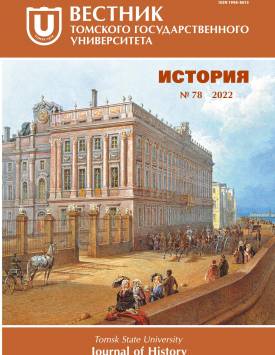Administrative Communication of Civil and Departmental Authorities in the South of Western Siberia of the 18th Century: Issues of Interaction in the Assessments of Contemporaries
The XVIII century has become a time of intensive reforms in the management environment for the Russian state. The article assumes the disclosure of the parameters and specifics of the perception by scientists and travellers of the XVIII century of the relationship and mutual influence of civil and departmental authorities in the south of Western Siberia. The analysis of this type of social-political relations allows us to identify latent priorities in the imperial management model, to reveal the strategies of administrative communications in the conditions of the decay feudal law system and the restructuring of the state bureaucratic system. The perception by pre-revolutionary travelers of the sociogeographical space within the framework of the routes and the issues of the administrative history of the region are still covered in Siberian historiography in isolation from each other. The source base of the research is presented by writings of scientists and travellers which are significant for the history of the region, therefore, the "close-up" method was chosen as the main method. These works were presented in different genres. The authors come to the conclusion that the involved works of scientists and travelers could not go beyond the historiographical tradition of their time. The dominance of the rational style of thinking and the striving to rely on archive mate- rials, which were combined with perceptible elements of narrative, pithiness of presentation and separate experiments in the construction of cause-and-effect relationships remained in these works. The method of presentation of P.S. Pallas, who used the personification technique to highlight the activities of various institutions, is identified. The method consists in extrapolating the characteristics of the personality and activities of managers to assess the effectuality of a particular managerial hierarchy. The coverage of the relations between the authorities of different industries was built in several main directions: jurisdiction of the local population, registration and control of the registered peasantry, to a lesser extent - the protection of industrial enterprises. G. F. Miller, who visited the region in the initial period of development, recorded the priority positions of general civil government over an immature departmental military and amorphic privately owned vertical. I. P. Falk, P. S. Pallas and I. F. Herman in their works exposed directly or indirectly the growing dominance of departmental (primarily mining) structures over civil ones in the second half of the century. The authors declare no conflicts of interests.
Keywords
Russian empire, writings of scientists and travellers, academic expeditions, administrative communication, management system, civil authorities, mining department, departmental military authorities, Western SiberiaAuthors
| Name | Organization | |
| Bobrov Denis S. | Altay State University | bds-eureka@yandex.ru |
| Goncharov Yuriy M. | Altay State University | yuriig@yandex.ru |
References

Administrative Communication of Civil and Departmental Authorities in the South of Western Siberia of the 18th Century: Issues of Interaction in the Assessments of Contemporaries | Tomsk State University Journal of History. 2022. № 78. DOI: 10.17223/19988613/78/1
